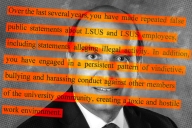You have /5 articles left.
Sign up for a free account or log in.
When a student’s worries about money are impacting the ability to keep up with coursework or other commitments, and perhaps dropping out seems like the only way out of the financial mess, that student might confide in just about anyone on campus.
Academic advisers, professors, resident assistants or student affairs staff are “often the first point of contact with students when they are in crisis,” says Paul Goebel, director of the Student Money Management Center at the University of North Texas. “Those first points of contact—and we as an entire campus community—must be aware of all resources.”
Student Voice explores higher education from the perspective of students, providing unique insights on their attitudes and opinions. Kaplan provides funding and insights to support Inside Higher Ed’s coverage of student polling data from College Pulse. Inside Higher Ed maintains editorial independence and full discretion over its coverage.
Resources related to student finances, from emergency assistance to proactive financial literacy education, are typically spread throughout campus. Goebel anticipates the concept of an integrated financial services department gaining momentum. A one-stop model focused on student financial business would make it simple for students to find whatever type of help they need, and it’s the direction his institution is headed. UNT’s Student Financial Support Center will provide integrated, cross-functional service in financial aid, scholarships and student accounts and will incorporate Goebel’s center.
While financial aid offices are a natural campus destination for help and support related to affording college, nearly one-third of students on financial aid have never interacted with the financial aid office, according to the latest Student Voice survey conducted by Inside Higher Ed and College Pulse, with support from Kaplan.
Among the 2,000 respondents, over half have student loans, and about one in four have credit card debt. Nearly one in 10 are past due on their student account at their college or university. While financial literacy offices and programs have gained traction in higher ed, only 8 percent of respondents say their institution requires a class or program in personal finance. And 21 percent are aware of an optional class or program.
A financial education initiative need not be comprehensive, however, and offices (and classrooms) across campus can help students grow money smarts or assist students in an emergency.
Scroll down for a visualization of areas—including some less expected ones—that are or could be involved in at least some aspect of student financial wellness.










